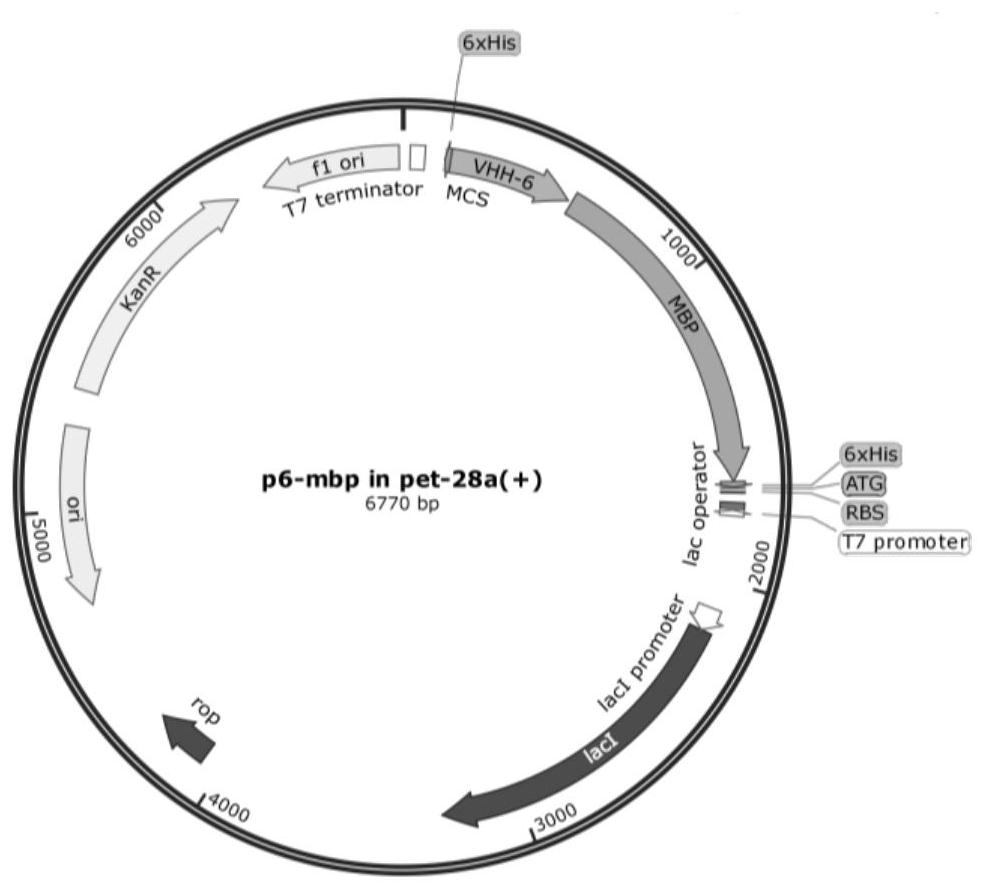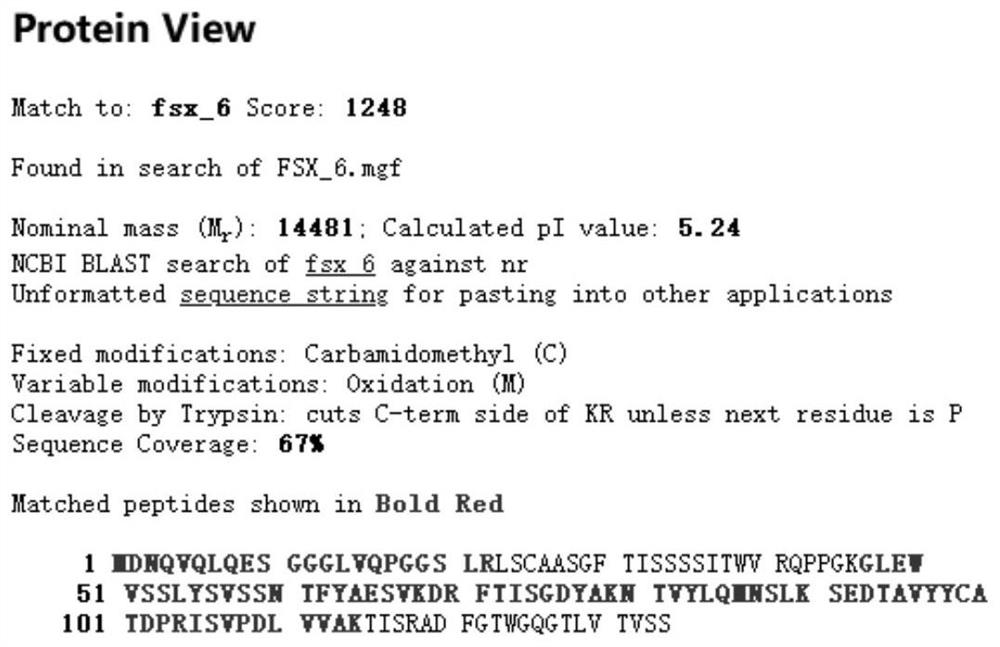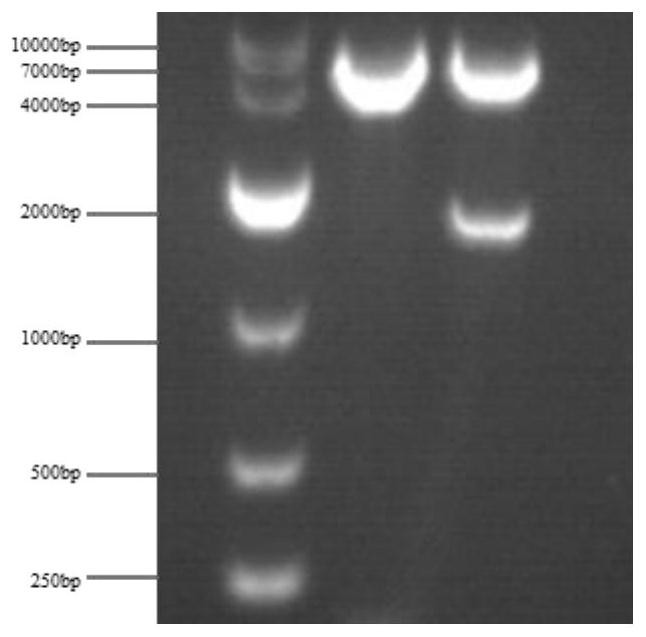Anti-H5 subtype avian influenza nano antibody protein as well as coding gene and application of nano antibody protein
A technology of nano-antibody and bird flu virus, applied in the direction of anti-viral immunoglobulin, antibody, application, etc., can solve the problems of high production cost and low output, and achieve the effect of low cost, high sensitivity and high purity
- Summary
- Abstract
- Description
- Claims
- Application Information
AI Technical Summary
Problems solved by technology
Method used
Image
Examples
Embodiment 1
[0057] Example 1 Construction of phage display library
[0058] (1) Immunize Xinjiang Bactrian camel (Lanzhou Animal Husbandry and Veterinary Research Institute, Gansu) with the hemagglutination inhibition test antigen (purchased from Harbin Veken Biotechnology Development Co., Ltd.) of avian influenza virus H5 subtype Re-8 strain, and immunize once every three weeks , a total of four times of immunization, the peripheral lymphatic blood of the immunized donor was extracted, and the peripheral blood lymphocytes (PBMC) were separated for RNA extraction and reverse transcription to obtain cDNA;
[0059] (2) The first round of nested PCR reaction: the first round of nested PCR reaction was carried out using the cDNA obtained in step (1) as a template, wherein the reaction system was: 2 μL of cDNA template, 10 μL of 2×Taq Plus Master Mix, primers CALL001 and 1 μL each of CALL002, with ddH 2 O was added to 20 μL; the amplification reaction conditions were: 95°C for 5 minutes; 95°C...
Embodiment 2
[0071] Example 2 Screening of phage nano-library
[0072] (1) The hemagglutination inhibition test antigen (purchased from Harbin Veken Biotechnology Development Co., Ltd.) of the H5 subtype Re-8 strain was coated with sodium carbonate-sodium bicarbonate buffer solution (0.05mol / L, pH=9.6). 100 μL per well on a microtiter plate, in which the antigen of the hemagglutination inhibition test of the H5 subtype Re-8 strain accounts for 10% by volume, put it at 37°C for 2 hours; discard the liquid in the well, and wash once with 300 μL PBS Then add 300 μL BSA with a mass percentage of 3% and place at room temperature to block for 1 h; discard the blocking solution, add 100 μL of the phage display library obtained in Example 1, and incubate at room temperature for 1 h; discard the liquid in the well and unbound phage, and then use Wash 5 times with PBS containing 0.05% Tween 20 by volume, 5min / time; add 100 μL of eluent containing 0.2M glycine (pH=2.7) and mix well, collect the eluat...
Embodiment 3
[0075] Example 3 ELISA screening positive monoclonal
[0076] (1) The phages screened out in the third round of Example 2 were first mixed with 5 mL of TG1 bacteria (OD 600 =0.5), after incubating at 37°C for 30 minutes, take 100 μL from the infecting bacterial solution for 10 N-th power gradient dilution, re-absorb 100 μL of the bacterial solution and streak on 2×YT / Amp / Glu solid medium respectively, at 37°C Cultivate overnight, then inoculate a single colony in 50mL of 2×YT / Amp / Glu liquid medium, culture overnight at 220rpm 37°C, pipette 1mL of bacterial liquid into 100mL of 2×YT / Amp / Glu liquid medium the next day, 220rpm 37°C Shake to OD 600 = about 0.6, add helper phage M13KO7 with multiplicity of infection MOI = 20:1, let stand at 37°C for 20 minutes, shake at 200 rpm for 30 minutes, carry out helper phage infection, centrifuge at 3000g to discard the supernatant including glucose in the medium, and use fresh 2 Resuspend in ×YT / Amp / Kana medium, shake culture overnight a...
PUM
 Login to View More
Login to View More Abstract
Description
Claims
Application Information
 Login to View More
Login to View More - R&D
- Intellectual Property
- Life Sciences
- Materials
- Tech Scout
- Unparalleled Data Quality
- Higher Quality Content
- 60% Fewer Hallucinations
Browse by: Latest US Patents, China's latest patents, Technical Efficacy Thesaurus, Application Domain, Technology Topic, Popular Technical Reports.
© 2025 PatSnap. All rights reserved.Legal|Privacy policy|Modern Slavery Act Transparency Statement|Sitemap|About US| Contact US: help@patsnap.com



